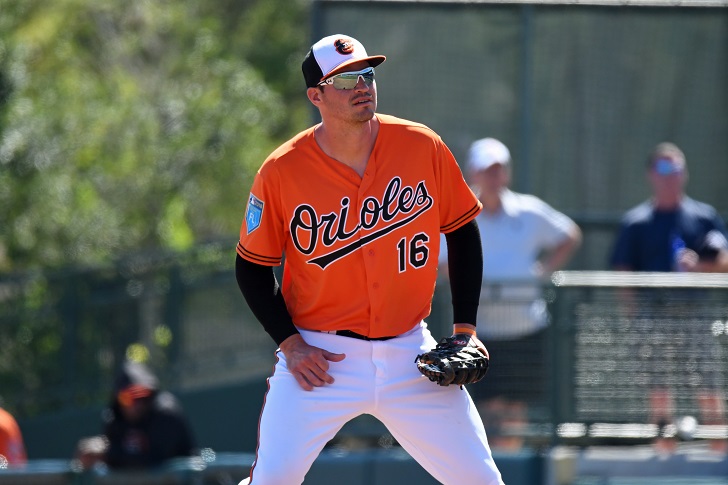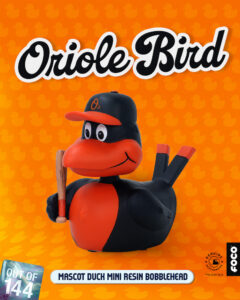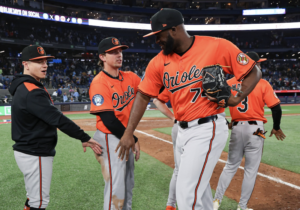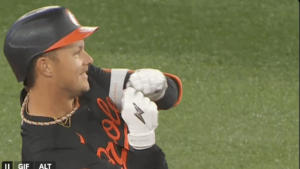A Quantitative Analysis of the 2019 Baltimore Orioles…so far
Alright baseball nerds, time to do a bit of a deep dive into the 2019 Birds as they begin to integrate data and information or ‘analytics’ into their play.
2019 marks a new era in Baltimore, accompanied by a new regime. I had the pleasure of sitting in on a book signing and Q&A with Astroball’s Ben Reiter along with Orioles Assistant GM and Head of Analytics Sig Mejdal on Friday, learning some valuable lessons.
First, analytical data doesn’t tell the whole story, but can vastly improve a ball club – for instance, showing spray chart tendencies and even telling a pitcher which pitches to throw depending on the count, and helping refine a hurler’s release point. The Houston Astros were on the cutting edge of this technology leading up to their 2017 World Series Championship (famously predicted by Reiter in a 2014 issue of Sports Illustrated).
Now, the Orioles have Sig and with him the knowledge of how to build an organization from the ground up into a champion.
Why doesn’t analytical data tell the whole story? Well, it was Mejdal himself who advised against the Astros trading for aging starter Justin Verlander and also Sig, who allowed J.D. Martinez to walk through the doors in Houston and become the superstar that he is today.
Here’s the good news: Analytics evolve and data models improve. Chemistry or ‘Chem WAR’ (Chemistry Wins Above Replacement) was mentioned in Astroball and may now be a part of the data assessment process. Mejdal is a certifiable genius in baseball circles, having previously worked for NASA and Lockheed Martin, before finding his true passion in baseball. He hopes to build up the analytics staff in due time, and as he mentioned during the Q&A, the Orioles have no shortage in the pool of candidates (with well over 500 applicants).
We know that the 2019 Orioles will be probably be pretty bad, and that’s okay. The Astros went by the moniker ‘Disastros’ for much of the beginning of the decade until their impromptu success in 2015, making the playoffs as a Wild Card team.
I see many valuable pieces on this Oriole team and ones that could either be flipped for future value, or players who could potentially play a role on the next playoff team.
To the data!
Spin Rate
Spin rate refers to how many rotations a ball would make if rotating for a full minute. This can often reveal effective velocity coupled with horizontal or vertical movement.
So which pitchers lead the Birds in spin rate?
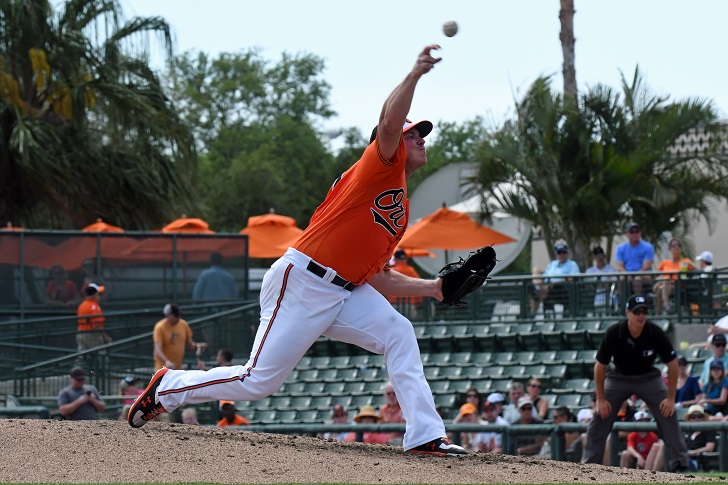
GulfBird Sports/Craig Landefeld
Fastball: Dylan Bundy, 2595 RPM
Yes, this may be surprising, because Dylan Bundy doesn’t throw particularly hard compared to even a few years ago. In fact, he ranks in only the 33rd percentile in terms of fastball velocity.
However, Bundy holds the O’s best fastball spin rate this season at 2595 RPM. This ranks his fastball spin rate in the 86th percentile in baseball. In his 1st start, Bundy produced some of the weakest contact we’ve seen this season. Small sample size yes, but Bundy made strides in his first start of 2019. Though he lasted just 3.2 innings in his season debut, Bundy recorded seven strikeouts. Walks were his big issue with a whopping five.
I look for Bundy to embrace analytics this year, because he still has good stuff and will get plenty of whiffs if he can locate his pitches. To put this into perspective, if Bundy were to average this spin rate for a full season, it would rank him 7th among all pitchers in baseball in 2018.
Clearly, thus far into the season, Bundy has been throwing far too many pitches per inning to be effective and will need to correct that immediately.
Slider: Miguel Castro, 3167 RPM
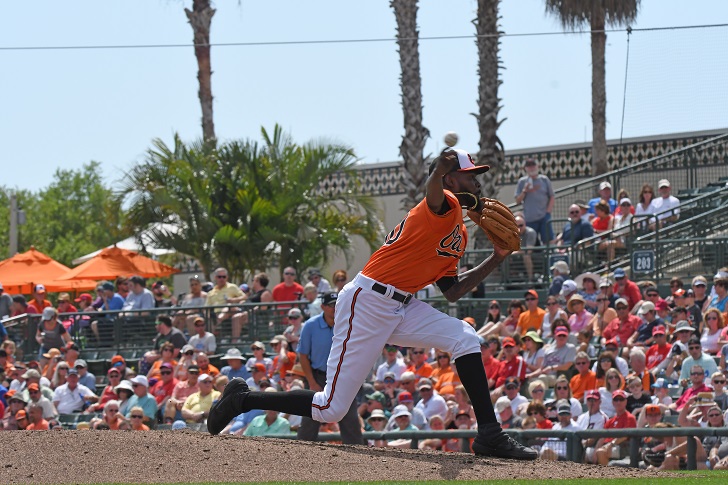
GulfBird Sports/Craig Landefeld
Miguel Castro has electrifying stuff, but doesn’t have dominant statistics. This is what gives me hope for him. The talent is there, the coaching staff just needs to harness and unleash it. Castro’s best slider this year came in at 3167 RPM’s. To put this into perspective, if Castro were to average this all season long, he would’ve ranked 2nd best in all of baseball in 2018. Castro’s fastball spin is just fairly average even if it does touch 98 mph and gets hit hard…his pitches were ‘barreled’ up 19 times last year, which ranks him in the 10th percentile of hardest hit pitchers.
To me, this suggests that Castro should be throwing his secondary pitches more than his fastball, an idea contrary to popular thought if his fastball velocity is considered elite. This way, Castro could get hitters off balance and fire a fastball past them later in the count when they’re least expecting it. Castro has been near disastrous so far, as it remains to be seen if he can actually sustain any amount of success.
Castro is actually most similar to Jimmy Yacabonis, whose slider and 2-seam movement is among the best in baseball. Fangraphs recently broke this down in depth. The Orioles have something in Castro and Yacabonis because of their pure stuff, but pitch sequencing will be key to their success.
xwOBA
xwOBA stands for Expected Weighted On Base Average. This stat takes into account exit velocity and launch angle and removes defense from the equation, allowing analysts to focus on the individual’s performance only.
Pitcher: David Hess, .217 xwOBA

GulfBird Sports/Craig Landefeld
We all watched as 2nd year pitcher David Hess was twirling a gem the other night where he took a no-hitter into the 7th inning before getting pulled by manager Brandon Hyde due to his pitch count. Hess has a different look this year. Yes, the beard is a noticeable difference, but he is pitching up in the zone with more purpose than before.
He is also using what is called ‘effective velocity.’ This term refers to the pitcher’s ability to influence a hitter’s bat-path to achieve a perceived velocity. For instance, with Hess pitching up in the zone, a hitter may have a harder time reaching the pitch to make contact. Hess is also throwing harder, touching 96 in his last start, while sitting 93-95 mph.
In his second start, Hess was far less effective. The Yankees touched him up for four runs over five frames as he allowed three home runs. All that being said, Hess’ expected wOBA is .217, which would’ve ranked 6th in all of Major League Baseball last year.
It’s doubtful Hess would achieve an xwOBA that stellar, but he is clearly adapting and sequencing his pitches in a way to ensure success early on.
Hitter: Trey Mancini, .424 xwOBA

GulfBird Sports/Craig Landefeld
Trey Mancini is off to a torrid start this year, compiling an absurd 1.081 OPS. He seems to be on a mission this year, after last year’s disappointing follow up to a Top 3 Rookie of the Year finish. Mancini will be key in this rebuild, providing incalculable leadership and guidance. But, he will also need to produce to solidify his spot with the club. He will either be traded for future assets or remain through the rebuild and be a bona fide star as a veteran on a young team.
Mancini’s current xwOBA ranks 19th in MLB, good for the top of the 3rd Tier of performance. His xSLG or weighted slugging percentage ranks in the Top 10. Notice his short and compact swing, generating lift that will make him a formidable power hitter this year.
Exit Velocity
Exit velocity refers to the speed the baseball as it comes off the bat, immediately after impact.
Hitter: Renato Nunez, 96.9 mph
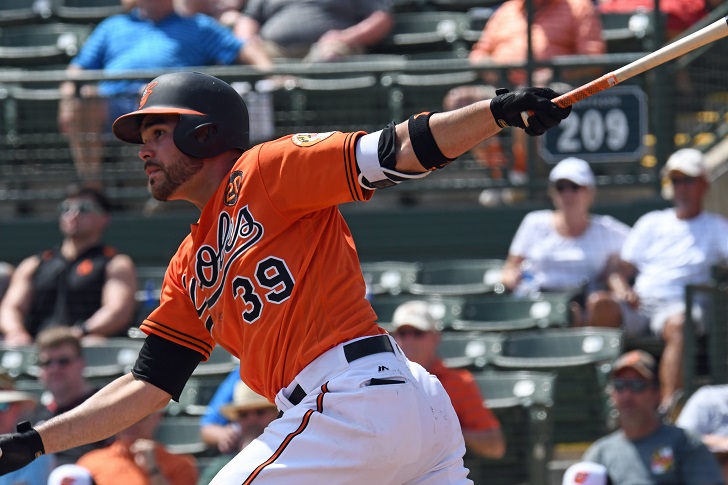
GulfBird Sports/Craig Landefeld
Renato Nunez is an interesting case, because he was a waiver claim by Dan Duquette in the previous regime and Elias & Co. don’t have any ties to him. Still, he made the club and has settled into a role. We already knew Renato could swing the bat, but his defense was always the question. His defense will remain a question, but if he produces with the wood, it makes him an attractive piece come July.
Nunez’s current average exit velocity of 96.9 mph ranks 4th in all the MLB and he has a higher max exit velocity than Cody Bellinger, the league’s current home run leader. Renato ranks in the 97th percentile in both exit velocity and hard hit %.
The hope is, that with power, comes some patience at the plate too. Analytical data could reveal to Nunez his hot and cold zones along with which pitches on which he’s most effective.
Pitcher: Mychal Givens, 82.6 mph
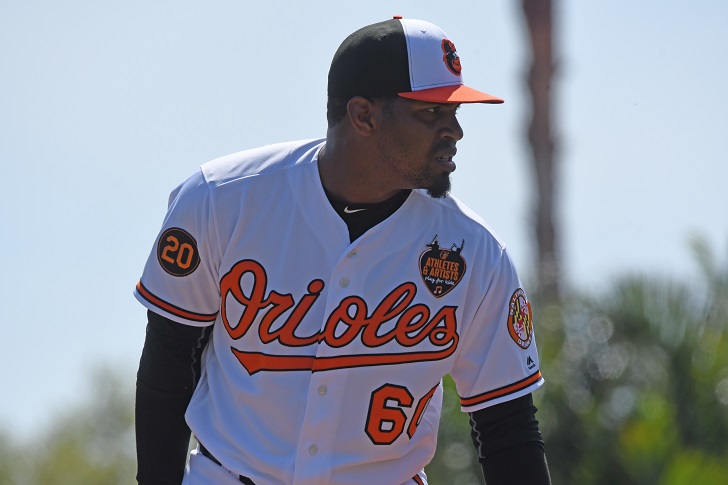
GulfBird Sports/Craig Landefeld
Givens ranks among the 30 best weak contact pitchers, partly due to his arm angle and fastball spin rate. Bundy barely edged out Givens’ spin rate, as the two’s best fastballs were 2595 RPM and 2518 RPM, respectively. 2018 saw Givens’ worst strikeout year since his rookie campaign in 2015 at 9.2 K/9. Mychal can get away with striking out fewer hitters as long as they are only producing weak contact. The idea behind Mike Elias bringing in players like Rio Ruiz and Richie Martin was to shore up the Orioles’ infield defense for pitchers who lack a strong strikeout rate. Givens’ peripherals look good so far as he has been used in some high-leverage situations.
Hyde wants to be cautious though, because his workload could be heavy early on if the rest of the O’s pen struggles.
Obviously, this is the smallest of samples sizes, but the purpose of this article is to illustrate that talent exists on the roster. I’ve brought up six unique players that I think already possess the talent, but with analytical data can further improve to reach their full potential. Ryan Pressly was a middling reliever before embracing information that would eventually lead to him to the top in fastball spin rate leaderboards.
I plan on writing a follow up article later in the year, once more data is collected and Orioles players have a chance to digest the data and put it into practice.
All statistics above courtesy of BaseballSavant.com.

